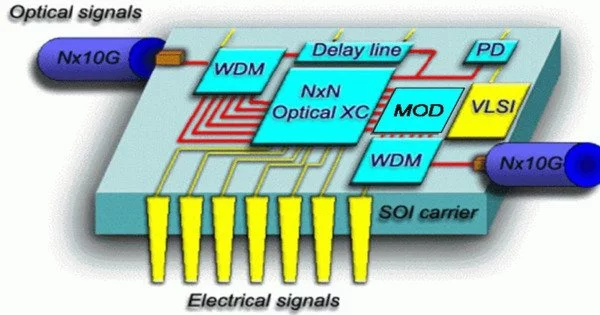A new type of network on chip (NoC) for multiprocessor system-on-chip is optical network-on-chip (ONoC). While traditional NoC uses electrical signals to transfer information and is thus known as an electrical network-on-chip (ENoC), its performance and energy efficiency are limited by the significantly unbalanced scaling of on-chip global metal wires when compared to transistors.
ONoC is a concept and technology aimed at meeting the growing demand for high-performance, energy-efficient communication within on-chip systems. It entails transferring data between different components and cores on a chip using optical interconnects rather than traditional electronic interconnects.
Data transfer between different components in traditional electronic systems is primarily accomplished via metal wires and electrical signaling. However, as chip designs became more complex and integrated, electrical interconnect limitations such as latency, power consumption, and bandwidth constraints became more pronounced. Optical interconnects, on the other hand, provide a number of benefits that make them appealing for on-chip communication.
Optical telecommunications have successfully replaced electrical telecommunications in many networking domains. A wide range of studies on ONoC have been conducted based on the achievements of photonic technologies.
The ability of optical interconnects to transmit data at high speeds while consuming less power than traditional electrical interconnects is their primary advantage. Optical signals have a higher bandwidth capacity and can achieve very high data transfer rates, allowing for efficient communication between different components on a chip. Furthermore, optical interconnects are impervious to electromagnetic interference and can transmit data over greater distances with minimal signal degradation.
An ONoC is typically made up of several photonic components integrated into the chip, such as lasers, modulators, detectors, and waveguides. These components allow electronic signals to be converted into optical signals and vice versa, facilitating data transmission via optical channels. The optical signals are routed through a network of waveguides or optical fibers, which provides high-bandwidth and low-latency communication paths between various cores and components.
The integration of photonic components into the chip fabrication process, the development of efficient routing algorithms, and the management of power consumption and thermal issues are all challenges in the implementation of ONoC. Researchers and engineers are actively investigating various techniques and technologies to overcome these obstacles and realize ONoC’s full potential.
















